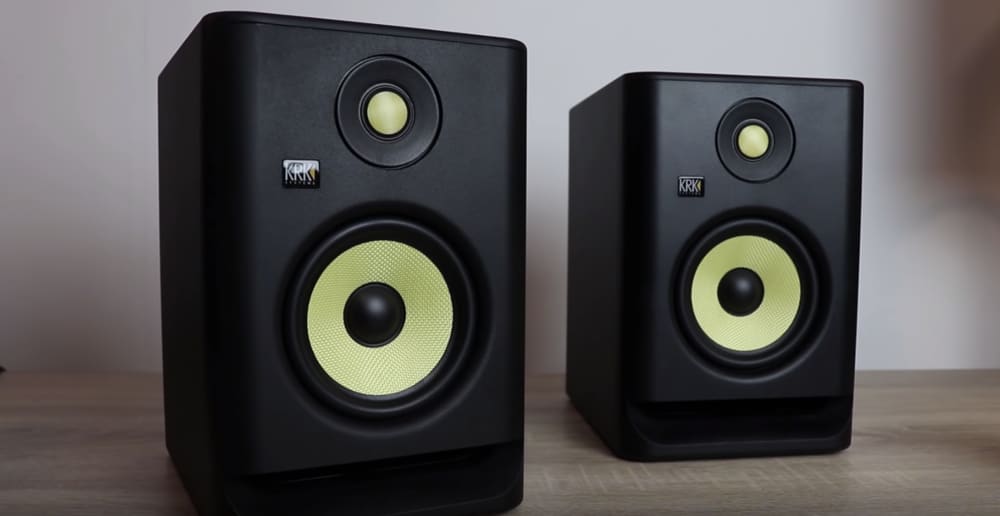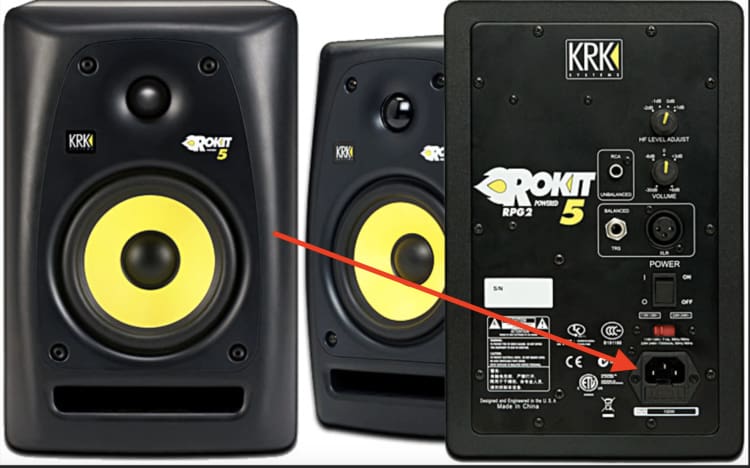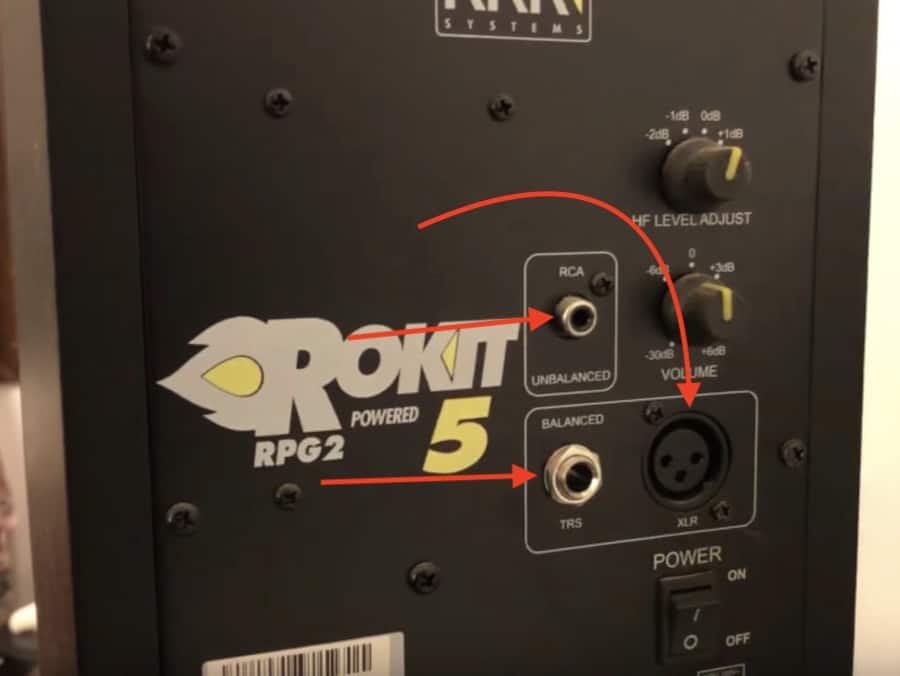As an Amazon Associate, I earn from qualifying purchases. Additionally, I earn a commission through each purchase made on Amazon, Clickbank, zZounds, Plugin Boutique, Plugin Fox, Thomann, Jam Play, and Punkademic from one of my links.
If you’ve arrived at this article, you’re in the market for a new pair of computer speakers, also known as – in this case – studio monitors.
When it comes to recording and music production, the KRK Rockit RP5 G4 Studio Monitors are some of the best speakers out there in their price range.
If you ever peruse the music production and beat-making side of Instagram and YouTube, I’m sure you’ve seen many people with these speakers.
KRK is a company that specializes in creating studio monitors; it’s what they do.
The company has a great reputation for making studio monitors, so it’s not uncommon at all to see beat-makers, producers, and mixers with the notorious yellow cone Rockit speakers.
The KRK Studio Monitors come in a range of different options, including the 3” speakers, 5”, 6”, and 8” speakers, and what ones you choose depends on 1) how big your room is, and 2) how much money you’re willing to spend. In fact, you can even get higher-end KRK monitors like the KRK V8 from Amazon.
I chose the KRK RP5 G4 Studio Monitors (also from Amazon), which are 5” speakers – more than enough for a small-to-medium-sized room, and they don’t cost a fortune.
The Rokit line of the KRK speakers are built especially for home recording studios, so these are exactly the monitors that we’re looking for, but if you’re more interested in a portable option, I recommend the iLoud Micro Monitors from Amazon instead, and I’ve written about them before as well.
Let’s get into the actual speakers.
The KRK RP5 G4 Studio Monitors
One different feature of these speakers is the fact they have a bass-port on the bottom of the speaker but on the front-end, rather than the back-end, which is different from other monitors in this price range.
From what I understand, the bass-port is constructed on the front-end of the bottom to combat against the phenomena where the low-end frequencies are pushed to the back of the room, either the wall or the corner of the wall.

The consequence of this is the amplification of low-end frequencies.
This should make sense. If you’ve ever driven by a house where there is extremely loud music playing, you’ll notice that by far, the loudest frequencies are the bass.
Low-end frequencies tend to be the loudest, because they accumulate, and they’re also just way easier to feel and hear.
If the bass frequencies accumulate in the wall and in the corners of your room, the bass will sound much louder than what you think, in addition to bothering your neighbors.
However, these speakers put the bass port in the front, which helps solve this problem, because there won’t be an accumulation of low-end anymore, particularly in comparison to monitors with the bass-port on the back.
The actual casing of the speakers, the housing, appears to be made out of wood, although it’s hard to tell exactly. Regardless, they’re solidly built and there are no loose pieces or shaky parts of the unit that will rattle when monitoring.
The unit comes with its own power-cord, because, in case you didn’t know, this isn’t a passive speaker. These are active speakers, so they have to be connected to a power source to work. The power outlet can be seen below on the older generation of these monitors.

Rather than connecting the speakers to your laptop, by the way, I recommend this MacBook Pro (from Amazon again) and have them be powered through your computer or receiver, there is an amplifier right in the unit that is meant fundamentally for powering the mid-range speaker, and the tweeter.
Another important point to mention that many people forget to add is the way in which KRK measures the speakers.
Truthfully, it’s an industry standard to do it this way, but KRK measures the total diameter of the speaker when determining just how big it is.
In other words, if you take off the casing of the speaker and measure from the left-side all the way to the right, it’s 5-inches.
If you’re measuring just the yellow part, you’re going to be disappointed because it won’t turn out to be 5 inches like you paid for. This is just the way speakers are made and measured, so don’t be mad.
In the power input, there is also a fuse in there that’s replaceable, that way if there is some kind of power surge or something horrible like that and the speaker blows, you can replace it if needed.
The unit itself is around 9 pounds, and there’s a rubber grip on the bottom of the speaker.
The purpose of the weight and the rubber-esque pad on the bottom is to ensure the speaker doesn’t jump, vibrate, or move around in a way that’s going to affect your ability to monitor.
The one-inch tweeter on the top of the unit has a frequency response up to 35,000kHz, which is well above what the human ear can actually hear, so you don’t have to worry about a lack of high frequencies, however, they’re not boosted like other monitors; they aim for balance.
The units themselves are actually sold independently, so when you buy a Rockit 5 G4 Studio Monitor, you only get one, on account of the fact they’re not meant for throwing parties or anything like that.
The reason why you should get 2, however, is because you want one for the left and one on the right, for the sake of capturing and conveying the entire “stereo image.”
The Stereo Image is a term that refers to the way in which sound – in all its frequencies, low, mid, and high – demonstrates itself to our ears (more on panning and the stereo image in my guide).
Explained in another way, the stereo image is the capacity for panning and mixing sounds so they appear as though they’re coming from all around the listener: behind, in front, to the side, and so on and so forth, rather than sounding like it’s just coming from two boxes.
Of course, it also comes with the manual as well, however, I feel like nobody ever looks at the instruction manual for two reasons: 1) the manuals are never that good, and 2) we all like to pretend we always know what we’re doing.
However, if you’re confused as to how to go about positioning them in your room, it’s worth noting that instructions for their placement come with the manual.
The idea behind placing them in a certain way is to optimize the angle to deliver the most balanced sound possible, which sounds like some audiophile nonsense, but it’s true.
The placement of the units will play a crucial role in their sound, in addition to the acoustics of your environment.
The standard placement rule for studio monitors is for the units to be as far apart from each other as they are to the listener.
In other words, if you’re sitting 3 feet away from the monitors, they should be 3 feet apart from each other, essentially creating an equilateral triangle between the two units and the mixer at the top of the triangle. Use a tape measure to set this up.

Additionally, it’s worth noting that these speakers aren’t meant for hosting parties or anything like that. They’re for a small home recording studio and are meant for monitoring and mixing.
If you’re looking to get a pair of speakers meant for house parties and DJing, then you should go somewhere else, because those are made to be appealing to the ear, rather than as honest as possible.
Furthermore, the Rockit 5 G4 Studio Monitors aren’t professional-grade monitors either. There are other units out there that cost thousands of dollars that are meant more for an actual recording studio.
The Rockit 5 G4 studio monitors are similar to the Audio Technica ATH M50x, which I wrote about in this article here, as both products are not quite a professional level but superior to the average products out there, including Dre Beats.
On the back of the speakers, there are two knobs, the volume knob, and the knob for adjusting the high-frequency levels.

The volume knob is for adjusting the output in relation to the other speaker – assuming you buy them in pairs, which you should – as well as the volume for pairing it with your audio interface.
The other knob allows you to cut or boost the high frequencies in your room. The purpose of the cut/boost knob for high frequencies is to account for variations in your room.
In case you didn’t know, different rooms have different acoustic and sonic environments. Some tend to be more conducive to high or low frequencies than others.
Some people might find this kind of confusing, so how would you go about determining at what level you should set the high-frequency knob on the back of the unit?
The best way to go about this is to use “reference mixes,” which just means that you’re listening to your favorite albums/songs and asking yourself how it sounds.
Listen closely with a pair of headphones like the ATH-M50x from Amazon and then play the same song back through your studio monitors and adjust the knob to match the sound of the headphones with the sound of the speakers.
Another thing you can do is listen to your favorite songs and albums on the monitors while walking around the room, for instance, maybe stand in the doorway, or go to the back of the room, into the kitchen.
Standing at different points in your room will illustrate what frequencies are disappearing, or whether it’s the room/wall that’s producing them rather than the speaker itself.
If you’re wondering whether or not you should get the 8”, 6”, or 5” speaker, it really depends on the size of your monitoring room.
If the room you’re producing and mixing is on the smaller side, you can opt for the smaller speaker. However, if you’re monitoring in a much larger room, opt for the larger speaker, the 8” or the 6”.
In terms of the connections, there is the standard RCA connection port on the back of the unit, in the case of having an unbalanced audio interface.

There is also the XLR cable port and the TRS port, which are balanced ports.
Why Should I Purchase A Pair Of KRK RP5 Studio Monitors?
In my article on the best headphones for music production and recording, I discussed the importance of picking up a pair of good studio monitors, which has to do with the way in which studio monitors are constructed in comparison to regular speakers.
Casual headphones and speakers are typically created with boosted frequency responses in certain ranges, depending on the speakers and what company made them.
For instance, if you use Dre Beats, which are casual-listening headphones, they have a boosted low-end which consumers usually find preferable.
If you go into Best Buy or some other retail store and ask for headphones, the employees there will probably direct you to a pair of headphones and tell you how “great the bass is,” because that’s usually what people are looking for.
It’s no coincidence that the boosted low-end is the selling point for the average consumer because the low-end is where the most difference can be heard. If the speakers/headphones have a boosted low-end, people feel like they’re getting their money’s worth.
However, this is no good for music production and recording because the way the speakers/headphones are made, color the sound of the music and therefore offer an inaccurate or incomplete picture of what the music really sounds like.
For recording and mixing, it’s best to have a pair of monitors or headphones that aren’t boosted in any range. In other words, we want a pair that aims to be “flat,” that way we have a more accurate understanding of what our mix really sounds like.
Conclusion
I hope this was helpful to you. If it was, make sure to share it on your social media with your producer friends.

 Written By :
Written By :